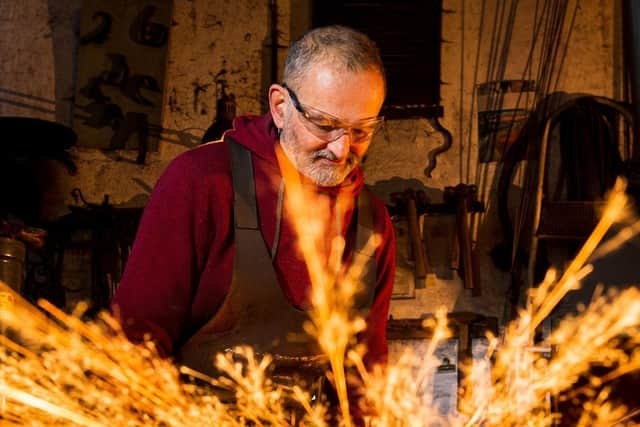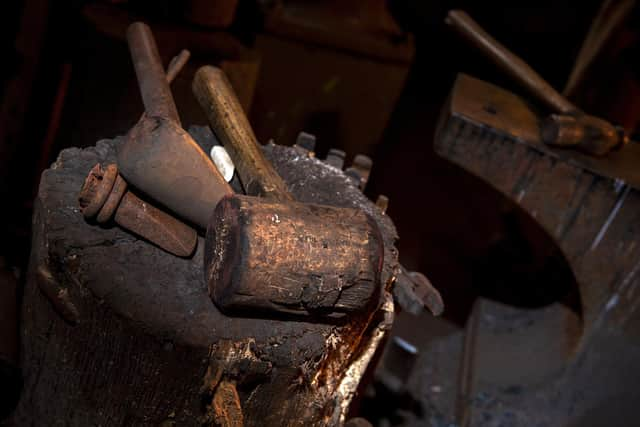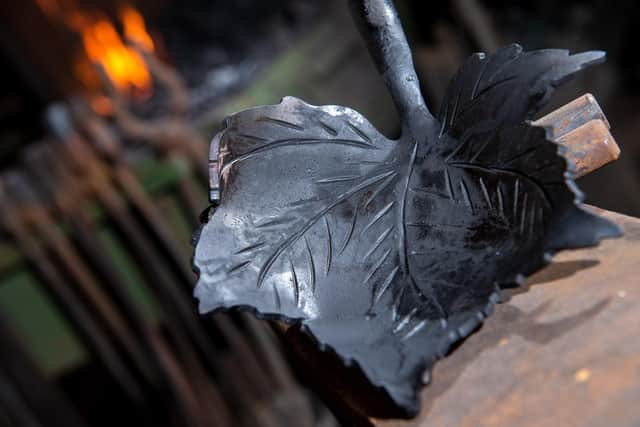The teacher who forged a new career as a blacksmith on the North York Moors


Undeterred by the fact that he had no experience or family connections to the trade, he set his sights on becoming a blacksmith,
“I’d taught at various places in this country, then spent time teaching in Madrid and three years at an international school in Bangkok,” David recalls.
Advertisement
Hide AdAdvertisement
Hide Ad“I thoroughly enjoyed teaching and the experience of travelling. I have no idea what made me want to go into it – I’d never seen or handled much work – but when I was living in Bangkok, I knew that when I came back to the UK I wanted to train as a blacksmith.”


And that’s exactly what he did. After investing in forging equipment, David resolved to give it a try and see how he got on, explaining: “I just tried to get a feel for it and, of course, I made a load of rubbish at first.”
After gaining some work experience with a blacksmith in the village of Egton, near Whitby, he then embarked on a six-month, part-time placement with the blacksmith artist Brian Russell, based near Barnard Castle.
“Brian is one of the best in Europe; it was quite inspiring,” says David. “He has a particular style in terms of his designs and the way he puts his work together. He has such attention to detail and there’s great integrity in his work. Some blacksmiths have a good idea but then put a piece together using an electric welder, so it looks as if it has sort of been glued together. Brian’s work flows because he uses a technique called fire welding.”
Advertisement
Hide AdAdvertisement
Hide AdAlso referred to as hammer welding or forge welding, fire welding is a process in which two pieces of metal are joined by heating them to a high temperature and then hammering them together.


“What I learnt during the six months I spent with Brian still influences my ideas about design and my ambition for my own work today.”
It wasn’t long before David had set up his own business as a blacksmith artist, although he initially continued to teach part-time and worked as a guide in the North York Moors National Park to help pay the bills. David’s partner, Sue Slack, now a well known landscape painter, left teaching at around the same to retrain as an artist.
Soon after, David successfully applied to the Countryside Agency, which is now part of Natural England, for a fully funded place at Herefordshire and Ludlow College, The National School of Blacksmithing, Farriery, Metalwork and Welding Courses.
Advertisement
Hide AdAdvertisement
Hide Ad“To receive the funding, your premises and work had to be inspected to show that it was of a reasonable standard and that you were not a complete beginner,” he says.


“I went to college for one week in eight and there were just six students on the course. I’d be working for myself for the other seven weeks and then we’d spend that one week at the college working intensively on a specific skill.
“We’d look at making an object using a particular technique. Fire welding would always be part of the project and then we’d look at the detail. For example, we might make a fire poker with a complex handle or focus on scroll work.”
It was on this course that David first produced pieces of work incorporating acanthus leaves, which have been a feature of ironwork in this country since the late 17th century. They were introduced by Jean Tijou, a French Huguenot ironworker whose intricate screens and grilles still adorn many famous landmarks today, including Hampton Court Palace, Kensington Palace and St Paul’s Cathedral.
Advertisement
Hide AdAdvertisement
Hide AdAcanthus leaves continue to appear in David’s work today, along with ferns and other botanical forms inspired by the beauty of the North York Moors National Park, which is where David, who originates from Middlesbrough, now lives and works.
He chose the peaceful village of Lockton as the base for his forge and his home is just a mile away from his workplace. At the time of our interview, there had been heavy snowfall in the area and David, a keen cross country skier, was looking forward to skiing home after work.
“About ten years ago, we had heavy snowfall for several weeks and it was ski-able for a month,” he says, adding: “Bankers may get a big bonus, but I have a better commute.”
As well as skiing, David enjoys walks in nearby Dalby forest with his Labrador, Pippa, and is a keen fell runner. Nature is a huge source of inspiration to him and it’s perhaps no coincidence that he originally trained as a zoologist and palaeontologist.
Advertisement
Hide AdAdvertisement
Hide Ad“Even from being a small child, I had an interest in the natural world,” he says. “The shape of a leaf might inspire my work and I always return to ferns in my sculptural pieces. I never tire of them; every spring I see them burst from the ground and gradually unfurl. They have such simplicity and I try to capture their essence. I try not to make my work overly complicated or fussy.”
Two decades on from that bold decision to embark on a career change, David’s business goes from strength to strength and his sculptural, contemporary designs are very much in demand. He also puts his teaching skills to good use by running courses for budding blacksmiths.
Reflecting upon his switch from teacher to blacksmith, he says: “I’m just lucky that I had reasonable competence once I tried it and that I’m still enjoying it 20 years on. I love the physicality of the process and fire is always fascinating; the fact that you can turn a solid bar into something moving. It’s a very tactile and physical process.
“In the early days I did a lot of design projects with schools, making gates or railings for them but involving the children in the process. You can often get very young children involved because plasticine behaves a lot like hot steel, so I worked in plasticine with the kids and would then go away and make their design.”
Advertisement
Hide AdAdvertisement
Hide AdA few years ago, David staged a solo exhibition at Ryedale Folk Museum in the village of Hutton-le-Hole. He was also asked to produce an ornate copper plaque for the entrance of the Laughton Gallery at Scarborough Art Gallery, which houses paintings donated by the famous hotelier Tom Laughton, who was the brother of the film star Charles Laughton.
Today, there are several strands to his work, but David describes commissions for gates and railings as his ‘bread and butter’. “I always work with a client on the design. I show them my portfolio and try to give them something a little bit different. My designs are very organic, with botanical influences, such as leaves, ferns and tendrils.”
He also produces domestic ironwork, such as pokers, candle holders and fireside sets. “I try to make them more interesting. Out of preference, I do more decorative work. Another strand is my sculptural work for galleries.”
He also runs intensive courses for aspiring blacksmiths keen to develop their skills, usually on a one-to-one basis.
Advertisement
Hide AdAdvertisement
Hide Ad“I get people who are working towards establishing their own business. Others are hobbyists who have set up their own outdoor forge. The emphasis is always on ensuring that people enjoy the courses.”
David can be found working at his forge most days, but admits that he enjoys the flexibility of self-employment because it enables him to care for his elderly mother and, on the occasions that snow falls on the North York Moors, to go and grab his skis...
Subject to the easing of restrictions aimed at limiting the spread of Covid-19, David hopes to exhibit at Lanercost Priory in Cumbria later this year, and his work is also on display at several Yorkshire galleries.
You can see his work at places including Leaping Hare in Easingwold, The National Park Visitor Centre at Sutton Bank and Lockton Tea Room and Gallery, as well as on his website (www.davidstephenson.org.uk).
Comment Guidelines
National World encourages reader discussion on our stories. User feedback, insights and back-and-forth exchanges add a rich layer of context to reporting. Please review our Community Guidelines before commenting.